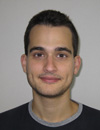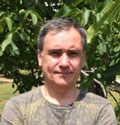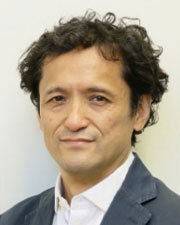Bio-electrical signals For Motor Control in Robotics:
Standardization of Muscle Synergy Analysis
Organizers: Alvaro Costa-Garcia, Massimo Sartori, An Qi, Kazuhiko Seki, Andrea d'Avella, Diego Torricelli, Yury Ivanenko, Andres Ubeda, Fady Alnajjar, Juan C. Moreno and Shingo Shimoda
Abstract
After millions of years of evolution, taking advantage of the evolved human motor strategies would allow deploying next generation agile robotic systems as well as deeply understanding movement. Endowing robots with biologically inspired behavior is a crucial step to bridge the advances of technological societies in which human-robot interaction has become symbiotic.
Many bio-electrical signals, like electromyography (EMG) can be acquired with wearable and increasingly cheap devices. Furthermore, they contain a high amount of information about the basic neuromuscular processes underlying human motion, which make them an efficient way to study motor control and design radically new robotic control schemes.
The analysis of sEMG signals has been widely used to study human motor control. From the initial bipolar electrodes to the appearance of modern high-density EMG systems, muscle activity has been used to decode a wide range of parameters involved on human motion. Recently, the study of muscle synergies shown great potential decomposing motion in basic patterns that can be implemented in robotic systems to emulate human inspired movements.
A variety of approaches have been proposed so far to compute and analyze muscle synergies. This situation makes difficult to stablish the common sense for further understanding of human motion control and its adaptation to bioinspired robot control systems. The development of a standard methodology for the treatment of sEMG signals before and after synergy extraction will be an important achievement toward the creation of an efficient and effective network to share data and results.
In this workshop, we will discuss the steps for the creation of such community introducing the state of the art of muscle synergies data processing and starting a network to share of software related to their extraction and analysis.
Schedule is tentative to fit to the official workshop schedule timelines.
| Time | Speaker | Title |
|---|---|---|
| PRE-RECORDED PRESENTATION |
An Qi | OP.1: Muscle Synergy of Human Sit-to-stand motion-Understanding, Diagnosis, and Rehabilitation- |
| PRE-RECORDED PRESENTATION |
Alvaro Costa Garcia | OP.2: Segmentation and averaging of data for muscle synergy extraction. |
| PRE-RECORDED PRESENTATION |
Diego Torricelli (EuroBench Section) |
OP.3: Bringing muscle synergy analysis into real-life environments. The EUROBENCH opportunity. |
| PRE-RECORDED PRESENTATION |
Andrea d'Avella | OP.4: Open issues and best practices in the analysis of muscle synergies |
| PRE-RECORDED PRESENTATION |
Yury Ivanenko | OP.5: Patterned control of human locomotion and its task dependence: muscle modules and spinal maps analysis. |
| PRE-RECORDED PRESENTATION |
Kazuhiko Seki | OP.6: Neural basis of hand muscle synergy in monkey and human: methodological consideration |
| PRE-RECORDED PRESENTATION |
Fady Alnajjar | OP.7:The Effect of Various Sensory Feedbacks in Muscle Synergy Formation and Motor Skill Adaptation: A VR-based Study. |
| PRE-RECORDED PRESENTATION |
Andres Ubeda Castellanos | OP.8: Neuromechanical Biomarkers of Motor Function |
| PRE-RECORDED PRESENTATION |
Massimo Sartori | OP.9: Extraction of neuromuscular primitives for diagnosis and movement restoration technologies. |
| PRE-RECORDED PRESENTATION |
Emel Demircan | OP.10: Understanding Human Perception in Manipulation and Locomotion Skills |
| 16:00–18:00 CEST | Live-Session |
■OP.1: Prof. An Qi --- Kyushu University

Qi An received his B.E., M.E., and Ph.D. degrees in Engineering from the University of Tokyo, Japan, in 2009, 2011, and 2014, respectively. From 2010 to 2011, he joined Yoky Matsuoka’s Lab as a visiting student at University of Washington, USA focusing on neuro-rehabilitation. From Nov/2014 to Mar/2015, he joined Martin Buss’s Lab as a visiting researcher at Technische Universitat Munchen, Germany working on control theory of assistive machine of human standing-up motion. From 2020, he is an Associate Professor at the Kyushu University. His research interest is to develop new rehabilitation system.
Title: Muscle Synergy of Human Sit-to-stand motion -Understanding, Diagnosis, and Rehabilitation-
Abstract: Human sit-to-stand motion consists of four muscle synergy (synchronized muscle activation), and humans can adaptively change amplitude and duration time of them to achieve movement. From our recent studies, it was found that post-stroke patients could appropriately control activation timing of muscle synergies due to motor impairment. However, their activation timing would be improved after rehabilitation. We also present that some characteristic parameters of muscle synergies could be bio marker of motor impairment.
■OP.2: Dr. Alvaro Costa-Garcia--- RIKEN, CBS-TOYOTA Collaboration Center

Álvaro Costa García is a research scientist at the Intelligent Behavior Control Unit, BSI, RIKEN. He received M.S. degree in Telecommunications Engineering from the Systems Engineering and Automation Department at the Miguel Hernández University of Elche, Spain (2013). He obtained a PhD in the Program on Industrial and Telecommunications Technology from the same university in 2016. During the PhD, his research was focused on lower limb rehabilitation methods and the study of cognitive mechanisms related to gait through the evaluation of electroencephalographic signals. Currently, he is studying the neural processes behind voluntarily motor control through the evaluation of electromyography and its applications in the field of neuro rehabilitation
Title:Segmentation and averaging of data for muscle synergy extraction.
Abstract: Capturing muscle synergies requires the preservation of accurate temporal and spatial information for muscle activity. The natural variation in electromyography data across consecutive repetitions of the same task raises several related challenges that make averaging a non-trivial process. Duration and triggering times of muscle activity generally vary across different repetitions of the same task. Therefore, it is necessary to define a robust methodology to segment and average muscle activity that deals with these issues. Emerging from this need, the present talk proposes a standard protocol for segmenting and averaging muscle activations from periodic motions in a way that accurately preserves the temporal and spatial information contained in the original data.
■OP.3: Dr. Diego Torricelli

Diego Torricelli received the MSc degree in Mechanical Engineering from the University of Roma TRE in 2004. His Master’s thesis was developed in Harvard Medical School, Boston, in the Gait Analysis Lab of the Spaulding Rehab Hospital. In 2009 he received the PhD in Biomedical Engineering from University of Roma TRE, with a thesis focused on eye-driven interfaces for rehabilitation. In 2008 he co-founded a spin-off company for the development of innovative human-computer interfaces. He is now working at the Bioengineering Group of CSIC in Madrid, focusing on the study of human motor control principles and their application to technology-based neurorehabilitation.
Title: Bringing muscle synergy analysis into real-life environments. The EUROBENCH opportunity.
Abstract:The analysis of muscle synergies is often confined to controlled environments (e.g. flat ground or treadmill locomotion, cycling, pointing/reaching tasks). Nevertheless, daily life activities are characterised by complex and variable skills in highly unstructured environments with variable and unpredictable sources of disturbance. How would the evidence and methods gained in the last 30 years of muscle synergy investigations apply to real-life situations?
The European project EUROBENCH is currently creating the first European framework for benchmarking of legged locomotion, which can provide the experimental and computational tools needed to answer this question. The framework includes:
1) A testing facility composed of mechatronic testbeds able to reproduce typical ‘out-of-the-lab’ environments (e.g. uneven terrains, slopes, stairs, obstacles) as well as external perturbations (e.g. pushes, unstable support surfaces).
2) A benchmarking software, which includes computational algorithms able to estimate bipedal locomotion performance from a multifaceted point of view, including kinematics, kinetic and muscle activity.
This framework offers an unprecedented opportunity for the community to realize standardized and replicable experiments in real-like situations, as well as to have common data formats and computational tools to compare results obtained by different labs around the world.
■OP.4: Prof. Andrea d’Avella--- IRCCS Fondazione Santa Lucia

Andrea d'Avella obtained a B.Sc. in Physics at Milan University, and a Ph.D. in Neuroscience at MIT in 2000. In 2003 he joined the Laboratory of Neuromotor Physiology at Fondazione Santa Lucia, Rome, Italy. Since 2015 he is Professor of Physiology in the Department of Biomedical, Dental Sciences and Morphofunctional Imaging at the University of Messina, Italy. His research over the years has focused on different aspects of sensorimotor control and learning, in healthy subjects and after neurological lesions. Current interests include muscle synergies and motor skill learning, inter-individual differences in real-life motor skills such as catching and throwing, applications of myoelectric control and virtual reality to neurorehabilitation.
Title: Open issues and best practices in the analysis of muscle synergies
Abstract: In the last 20 years a growing number of studies have used dimensionality reduction algorithms such as non-negative matrix factorization (NMF) to decompose sEMG signals recorded from several muscles as combination of a few muscle synergies. While the interpretation of muscle synergies as basic building blocks organized by the CNS for generating motor commands is still debated, there is no doubt that the experimental design and the choice of analysis parameters used for the identification of muscle synergies affect the results. For example, the number of different conditions of a motor task included in a dataset significantly affect whether the muscle synergies can be interpreted as building blocks shared across conditions rather than a compact description of a conditions-specific muscle pattern. Moreover, the number of synergies used to reconstruct a dataset is a free parameter which is often selected according to the fraction of data variation explained. However, the choice of any selection threshold is in principle arbitrary unless an independent estimate of the noise contribution to the data variation is available. Finally, the comparison between sets of synergies identified in different tasks or in different individuals depends on several assumptions and choices of analysis parameters that need to be validated. In this talk, I will address these issues, reviewing some of the solutions proposed in the literature and discussing the steps necessary to move towards a validation and standardization of the analytical approaches, thus ensuring that muscle synergies provide new insights into motor control.
■OP.5: Prof. Yury Ivanenko--- IRCCS Fondazione Santa

Yury Ivanenko obtained a combined B.S. and M.S. degree in Biophysics at Moscow Physics and Technology Institute in 1982 and then PhD in 1987 at the same Institute. He joined the Motor Control Laboratory headed by Prof. Victor Gurfinkel at the Institute for Information Transmission Problems, Russian Academy of Sciences (Moscow). Then he was a lecturer in biophysics and biochemistry at the Ryazan Medical University (Russia). In 1995-98 he did a post-doc in the laboratory of Prof. Berthoz at the Collège de France in Paris, and since then he has been working in the Department of Neuromotor Physiology (headed by Prof. Francesco Lacquaniti) at the Fondazione Santa Lucia. Current position - Research Director, responsible for Gait Laboratory. Research interests include gait and posture control, early development of locomotion, gait pathologies, neurophysiology, biomechanics, motion perception and spatial orientation, body scheme, multisensory interactions and computational neuroscience.
Title: Patterned control of human locomotion and its task dependence: muscle modules and spinal maps analysis.
Abstract:This presentation will outline recent advances in understanding how motor commands are expressed during human locomotion. Each human lower limb contains over 50 muscles, comprising many intrinsic foot muscles, that are coordinated during locomotion. The coordination of limb and body segments arises from the coupling of neural oscillators between each other and with limb mechanical oscillators. Muscle activations need to intervene during limited time epochs to force intrinsic oscillations of the system when energy is lost. The nervous system may control numerous muscles through modularity, using neural patterns to activate muscles in groups. The utility of such shared motor modules may also depend on whether they can be adapted for specific task demands. Indeed, the interaction of central and peripheral factors in the control of human locomotion is a long-standing topic and any reflection on the spatiotemporal organization of muscle activity should also include a consideration of its task-dependence. User-friendly software for synergy and spinal map analyses from sEMG data will be presented for evaluating and understanding the patterned control of human locomotion.
■OP.6: Prof. Kazuhiko Seki---National Center of Neurology and Psychiatry

Kazuhiko SEKI received his Ph.D. degrees in Neurophysiology, University of Tsukuba, Tukuba, Japan in 1997. From 1997と2001, he joined Eb Fetz’s Lab as a long-term fellow of HFSPO at University of Washington, USA focusing on the neural control of limb movements. From 2001 to 2009, he was an Assistant Professor, Department of Developmental Physiology, National Institute for Physiological Sciences, Aichi, Japan, and then appointed as a Director, Department of Neurophysiology, National Institute of Neuroscience, National Center of Neurology and Psychiatry, Tokyo, Japan. His research interest is the neural mechanism in the control of voluntary movement.
Title:Neural basis of hand muscle synergy in monkey and human: methodological consideration
Abstract: In this talk it will be introduced the way we describe the neural basis of muscle synergy based on the physiological recording from neuronal and muscular activities in monkeys, and how we relate them to the conventional muscle synergy extracted from the surface EMG of human. It will be also pointed out the limitation of this approach and needs for novel software to overcome this gap.
■OP.7: Prof. Fady Alnajjar---United Arab Emirates University

Fady S. Alnajjar received the M.Sc. degree in artificial intelligence and the Ph.D. degree in system design engineering from the University of Fukui, Fukui, Japan, in 2007 and 2010, respectively. He is currently an Assistant Professor with the Department of Computer Science and Software Engineering, College of IT, United Arab Emirates University, UAE, He is also a team-leader for AI and Robotics Lab, in the same university, and a visiting researcher at RIKEN center of brain science, Japan. His main research interest is studying and understanding Human behaviors, whether it concerns understanding neuromuscular strategies in learning, adaptation and recovery, or brain’s neural dynamics and cognitive functions.
Title:The Effect of Various Sensory Feedbacks in Muscle Synergy Formation and Motor Skill Adaptation: A VR-based Study.
Abstract:The development of Motor skills, or motor recovery, is a result of proper muscle synergies recruitment. This recruitment is done by the central nervous system (CNS) which highly depends on environmental sensory feedback. Finding optimal biofeedback to the CNS may speed up the recruitment process of the proper muscle synergy. In this talk, we will discuss the effects of various sensory feedbacks including auditory, cognitive, tactile, and visual feedback systems in motor skill training. A Virtual Reality (VR) interface was built to facilitate the study and to better motivate the participants to complete their assigned tasks.
■OP.8: Prof. Andres Ubeda---University of Alicante

Andrés Úbeda is Assosiate professor in the Department of Physics, System Engineering and Signal Theory of the University of Alicante and Head of the research group HUman RObotics (HURO). He holds a M.Sc in Industrial Engineering from the University Miguel Hernández (2009) and a Ph.D. in Bioengineering from the University Miguel Hernández (2014). He has been visiting researcher at the Defitech Chair in Non-Invasive Brain-Machine Interfaces (CNBI) at the EPFL (École polytechnique fédérale de Lausanne, Switzerland) (May-July 2013), at the Institute of Neurorehabilitation Systems (Universitätsmedizin Göttingen, Germany) (Sep 2015-Sep 2016) and at the Department of Bioengineering (Imperial College, London) (Jun-Jul 2019). His main research is focused on studying neuromuscular mechanisms of motor control and coordination by assessing descending motor pathways during movement execution.
Title:Neuromechanical Biomarkers of Motor Function
Abstract:Clinical evaluation of motor function is an essential tool to track the patient’s evolution during rehabilitation sessions at healthcare centers. An accurate tracking of this evolution allows the therapist to modify parameters of the rehabilitation process such as intensity, number of repetitions or targeted motor activity. Conventional evaluation methods are based on qualitative clinical metrics with low resolution, such as Fugl-Meyer or Ashworth scales. The correct interpretation of these scales usually depends on the experience of the therapist. As a consequence, the evaluation of functional recovery suffers the risk of being incomplete or inaccurate. Surface electromyography (EMG) allows measuring neuromuscular behavior in an accurate way. From muscle synergies to neuromuscular latencies, now we are capable of extracting significant information of the motor function by evaluating a variety of neuromechanical biomarkers. Also, recent breakthroughs in EMG signal processing techniques, such as the introduction of high-density EMG, have broken new ground in our understanding of motor control all the way down to the motor unit level and provide a novel approach to the determination of these biomarkers.
■OP.9: Prof. Masimo Sartori---University of Twente

Associate Professor at the University of Twente where I direct the Neuromechanical Modelling & Engineering Lab. My team and I investigate the basic neuromuscular mechanisms underlying healthy and impaired movement. Our goal is to discover fundamental principles of movement at the interface between humans and wearable robots ultimately for enhancing human health. On these topics, I am PI of personal grants (e.g. ERC Starting Grant) and consortium-based projects (e.g. H2020-Research and Innovation Actions and H2020-Innovative Training Network).
I conducted my PhD in Information Engineering at the University of Padova (Italy, 2009-2011) and was visiting scholar at the Universities of Western Australia (Australia) and Stanford (USA). I was a post-doc fellow at the University of Göttingen (Germany, 2012) where I become a Junior Research Group Leader in 2015. Since 2017 I am a tenure-track scientist.
Title: Extraction of neuromuscular primitives for diagnosis and movement restoration technologies.
Abstract: Over 15 million people suffer from stroke each year worldwide. However, current neuro-rehabilitation treatments are sub-optimal. The main reason is that movement assessment is currently done using subjective and not precise techniques. This talk will present advances in electromyography and neuro-mechanical modelling techniques that enable reliable estimation musculoskeletal forces in the intact moving human. The talk will discuss how availability of this information in conjunction with wearable technologies can be used to transform the way treatment is designed, planned and performed.
■OP.10: Prof. Emel Demircan--- California State University

Dr. Emel Demircan is an Assistant Professor at the Departments of Mechanical and Aerospace Engineering and Biomedical Engineering at California State University, Long Beach. Dr. Demircan obtained her Ph.D in Mechanical Engineering from Stanford University in 2012. She was a postdoctoral scholar at Stanford from 2012 to 2014 and a visiting assistant professor at University of Tokyo from 2014 to 2015. She was also a part-time scientist at Lucile Salter Packard Children's Hospital Gait Analysis Lab at Stanford University. Dr. Demircan's research focuses on the application of dynamics and control theory for the simulation and analysis of biomechanical and robotic systems. Her research interests include cyber-physical systems, rehabilitation robotics, sports biomechanics, natural motion generation in humanoid robotics, and human motion synthesis. Dr. Demircan is an OpenSim Fellow; and the founder & co-chair of the IEEE RAS Technical Committee on "Human Movement Understanding."
Title: Understanding Human Perception in Manipulation and Locomotion Skills
Abstract:Human motor performance is a key area of investigation in biomechanics, robotics, and machine learning. Understanding human neuromuscular control is important to synthesize prosthetic motions and ensure safe human-robot interaction. Building controllable biomechanical models through modeling and algorithmic tools from both robotics and biomechanics increases our scientific understanding of musculoskeletal mechanics and control. The resulting models can consequently help quantifying the characteristics of a subject’s motion and in designing effective treatments, like predictive simulations and motion training. My objective is to explore how neural control dictates motor performance in humans by developing a portable, soft, cyber-physical system and a computational framework - which incorporates real-time robotics-based control, AI-based perception and learning, and OpenSim’s musculoskeletal models. In this talk, I will present the modeling, control, and simulation components of this new framework with two examples on human manipulation and locomotion skills. The presented framework has promise to advance the field of rehabilitation robotics by deepening our scientific understanding of human motor performance dictated by musculoskeletal physics and neural control. Automated and real-time motion improvement and retraining, facilitated with such frameworks, promise to transform the neuromuscular health, longevity, and independence of millions of people, utilizing a cost-effective approach.
Contact Organizers
Dr. Alvaro Costa-Garcia
RIKEN CBS-TOYOTA Collaboration Center
alvaro.costagarcia[at]riken.jp